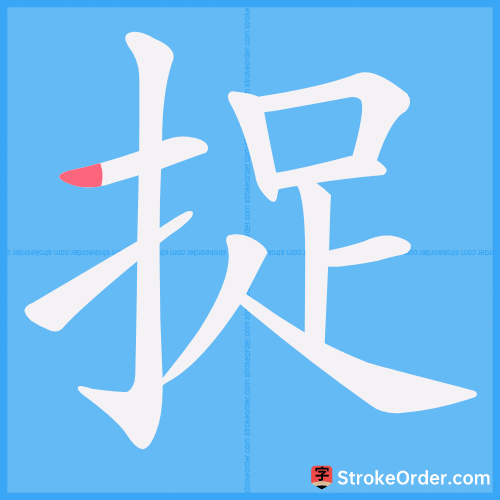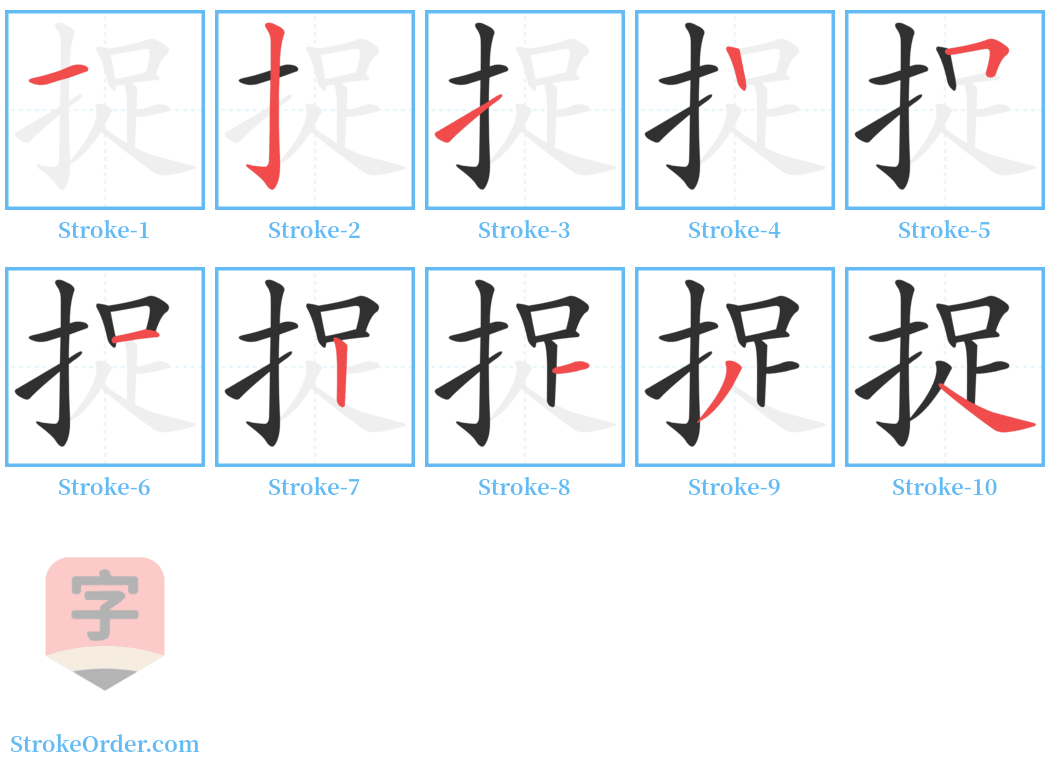捉 Stroke Order
Animated Stroke Order of 捉

Stroke Order Diagrams for 捉

Step-by-Step Handwriting Guide for 捉

Learn to Write Chinese Characters with Video Tutorials
Watch the video of writing the Chinese character "捉", learn the correct stroke order (笔顺) of the character "捉", and master the standard way of writing the character "捉".
Free Printable Handwriting Practice with Stroke Order: 捉
Printable Writing Practice Worksheet of "捉" in Portrait Orientation (Tian Zi Ge)

Printable Writing Practice Worksheet of "捉" in Landscape Orientation (Tian Zi Ge)

Information of 捉
Pinyin
zhuō
Radical
扌
Strokes
10 strokes
Usage
★★★★★
Definition
to clutch / to grab / to capture
捉 [zhuō]
1. To grasp; to catch.
- Examples: 捉拿 (to capture), 捉奸 (to catch in the act), 捉贼 (to catch a thief), 捉弄 (to make fun of), 捕捉 (to catch), 捕风捉影 (to catch shadows).
2. To hold.
- Examples: 捉笔 (to hold a pen), 捉刀 (to take over writing), 捉襟见肘 (to have one’s hands full).
---
捉 [zhuō] (verb)
【Original Meaning】: To hold, to grasp.
【Character Formation】: Phono-semantic compound; from hand, with a phonetic component.
1. Same as the original meaning ([En.] hold; grasp).
2. Extended meaning since the Tang dynasty: to catch, to arrest; [En.] to catch; to apprehend.
- Examples:
- 唐·杜甫《石壕吏》: At dusk, I entered Shigao Village, and there were officials catching people at night.
- 《三国志》: Sun Quan caught Yu by the hand, shedding tears as they parted.
3. To make fun of ([En.] to tease).
- Example: 受了别人家捉 ([En.] was made fun of by others).
4. To pick up ([En.] to collect).
- Example: 若见女人一发在地,自言持戒,不肯捉之 ([En.] if one sees a woman’s hair on the ground and claims to be virtuous, they would not pick it up).
5. To find, to take advantage of ([En.] to find).
- Example: 找个空 ([En.] find a gap or opportunity).
6. To control ([En.] to manage).
- Example: 捉不住 ([En.] unable to control).
---
捉 [zhuō] (preposition)
Equivalent to "把" or "将" (to handle something).
Examples:
- 吃了却捉什么还他? ([En.] What could I possibly return to him after eating?)
- 向吾宅里坐,却捉主人欺 ([En.] Sat in my home, yet took advantage of the host).
lit. pulling on the lapels exposes the elbows (idiom) / strapped for cash / unable to make ends meet
lit. chasing the wind and clutching at shadows (idiom); fig. groundless accusations / to act on hearsay evidence
elusive / unpredictable / guessed what was happening but did not know what was really taking place. / difficult to ascertain
lit. a thief crying "Stop the thief!" (idiom) / fig. to accuse sb of a theft and try to sneak away oneself / to cover up one's misdeeds by shifting the blame onto others
Input Method for 捉
Pinyin
zhuo1
Wubi
rkhy
Cangjie
qryo
Zhengma
dji
Four Corner
56081
Unicode
U+6349
Same Pronunciation Characters